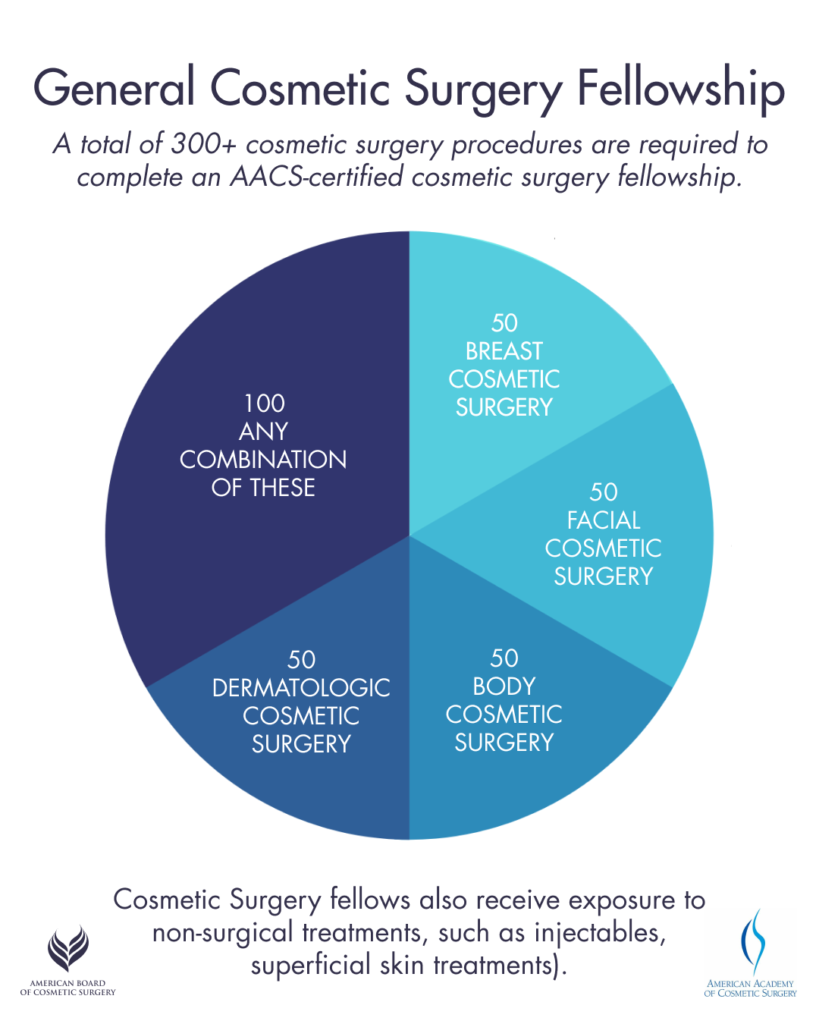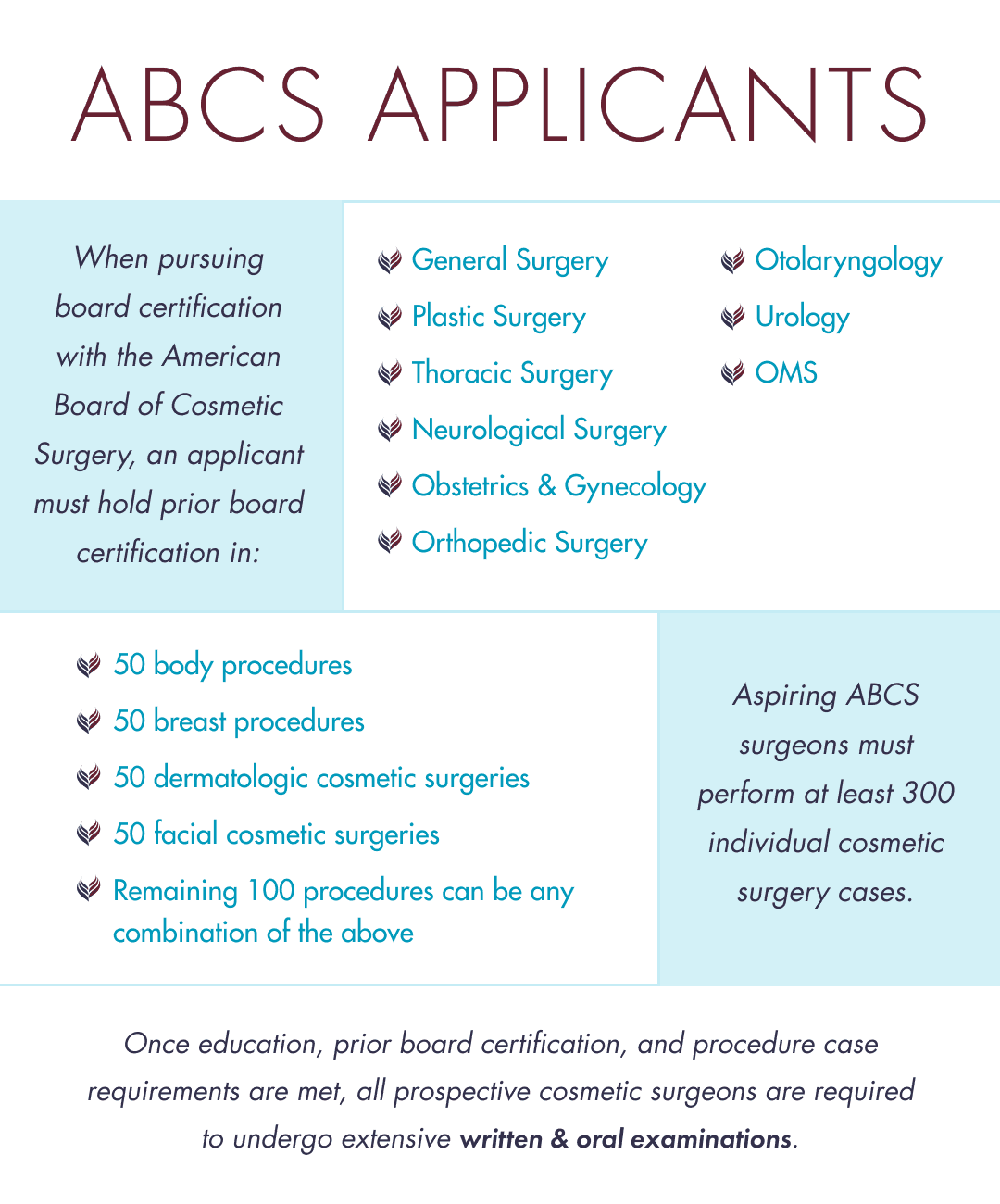What Type of Training is Required to be Board Certified in Cosmetic Surgery?
You know that becoming board certified means that a surgeon has met a certain set of standards for training and experience, but unless you know what those standards are, it’s difficult to make a confident comparison between doctors you may be considering. Before a surgeon can become board certified by us, he or she must complete the following types of training beyond a medical degree:
1. Complete an ACGME or AOA Residency Program in a Related Specialty
An ABCS candidate must first complete an approved ACGME or AOA residency program in one of the following surgical specialties:
- General surgery
- Plastic Surgery
- Neurological Surgery
- Obstetrics and Gynecology
- Orthopedic Surgery
- Otolaryngology
- Thoracic Surgery
- Urology
- American Board of Oral and Maxillofacial Surgery (ABOMS) with M.D. degree
With all specialties except plastic surgery, the candidate surgeon must also be board certified in one or more of these specialties, by a board recognized by the American Board of Medical Specialties (ABMS), the American Osteopathic Association (AOA), the American Board of Oral and Maxillofacial Surgery (ABOMS), or the Royal College of Physicians and Surgeons of Canada (RCPSC). Typically surgeons must obtain additional practice experience as well as pass rigorous examinations as specified by that board. In other words, most ABCS surgeons are already board certified before applying for a second board certification in the specialty of cosmetic surgery.
Surgeons whose primary speciality training is in plastic surgery, who have completed an ACGME approved Plastic Surgery Residency and also completed either an AACS Cosmetic Surgery Fellowship or an American Board of Plastic Surgery (ABPS) Aesthetic Plastic Surgery Fellowship that meets the minimum required cases of an equivalent to a cosmetic surgery fellowship set by the ABCS, are eligible for ABCS membership without a primary board certification.
2. Complete an AACS Certified Fellowship in Cosmetic Surgery
Once a candidate has completed residency training in one of the above specialties, they can apply to an AACS certified cosmetic surgery fellowship, which is a full-time training program lasting at least 1 to 2 years, depending on the surgeon’s initial residency training.
Programs must be approved by the American Board of Cosmetic Surgery, certified by the American Academy of Cosmetic Surgery, affiliated with an accredited hospital or surgery center, and include a teaching staff surgeon with an academic appointment. Cosmetic surgery fellowship is a full-time program; participants may not conduct concurrent academic work or private practice during their fellowship training. There are currently 21 such programs, and during their year of fellowship training, surgeons obtain the following:
- Comprehensive training in principles of aesthetics, cosmetic surgery procedures, management of patients during consultation, pre-operative work up, during surgical procedure, post-operative care, and management of complications arising from cosmetic surgery.
- Additional training in patient care: recognizing psychological issues associated with cosmetic surgery (i.e., body dysmorphic disorder), conducting initial patient consultations, and managing expectations.
- Additional training in non-invasive modalities such as injection of neurotoxins & fillers, laser skincare, chemical peels, and other cosmetic non-surgical treatments.
Remember, this comprehensive training is all conducted after already completing an approved residency program, which is typically the highest level of post-graduate training required for board certification in a medical specialty, such as the American Board of Plastic Surgery. During a cosmetic surgery fellowship, surgeons must perform at least 300 individual cosmetic surgery procedures, including a minimum of:
- 50 procedures of the body or extremities
- 50 cosmetic breast surgery procedures
- 50 dermatologic cosmetic surgeries
- 50 facial cosmetic surgeries
- Remaining 100 procedures can be any combination of the above
Only after successfully completing this sequence of training and experience, as well as meeting a number of other requirements, a surgeon may apply to become a diplomate of the American Board of Cosmetic Surgery.

3. Pass Written and Oral Exams
Once education, prior board certification, and AACS certified fellowship requirements are met, all prospective cosmetic surgeons are required to undergo extensive examination by the American Board of Cosmetic Surgery to receive ABCS board certification.
The ABCS Annual Certifying Examination consists of both an oral and written component. The content of both examinations cover the full scope of cosmetic surgery. Topics include technological devices—such as laser and radio-frequency therapy—hair transplant, injectable treatments, body contouring after weight loss, and facial, breast, and body cosmetic surgery procedures. This exam is prepared and psychometrically evaluated by the National Board of Osteopathic Medical Examiners (NBOME); the nationally recognized leader and examination administrator for the osteopathic medical profession.
The ABCS Annual Certifying Examination is designed to evaluate competency in cosmetic surgery by critiquing a combination of a candidate’s knowledge, surgical judgment, technical expertise, and ethics in order to achieve the goal of providing aesthetic improvement.

